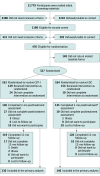Effect of Telephone Cognitive Behavioral Therapy for Insomnia in Older Adults With Osteoarthritis Pain: A Randomized Clinical Trial
- PMID: 33616613
- PMCID: PMC7900930
- DOI: 10.1001/jamainternmed.2020.9049
Effect of Telephone Cognitive Behavioral Therapy for Insomnia in Older Adults With Osteoarthritis Pain: A Randomized Clinical Trial
Abstract
Importance: Scalable delivery models of cognitive behavioral therapy for insomnia (CBT-I), an effective treatment, are needed for widespread implementation, particularly in rural and underserved populations lacking ready access to insomnia treatment.
Objective: To evaluate the effectiveness of telephone CBT-I vs education-only control (EOC) in older adults with moderate to severe osteoarthritis pain.
Design, setting, and participants: This is a randomized clinical trial of 327 participants 60 years and older who were recruited statewide through Kaiser Permanente Washington from September 2016 to December 2018. Participants were double screened 3 weeks apart for moderate to severe insomnia and osteoarthritis (OA) pain symptoms. Blinded assessments were conducted at baseline, after 2 months posttreatment, and at 12-month follow-up.
Interventions: Six 20- to 30-minute telephone sessions provided over 8 weeks. Participants submitted daily diaries and received group-specific educational materials. The CBT-I instruction included sleep restriction, stimulus control, sleep hygiene, cognitive restructuring, and homework. The EOC group received information about sleep and OA.
Main outcomes and measures: The primary outcome was score on the Insomnia Severity Index (ISI) at 2 months posttreatment and 12-month follow-up. Secondary outcomes included pain (score on the Brief Pain Inventory-short form), depression (score on the 8-item Patient Health Questionnaire), and fatigue (score on the Flinders Fatigue Scale).
Results: Of the 327 participants, the mean (SD) age was 70.2 (6.8) years, and 244 (74.6%) were women. In the 282 participants with follow-up ISI data, the total 2-month posttreatment ISI scores decreased 8.1 points in the CBT-I group and 4.8 points in the EOC group, an adjusted mean between-group difference of -3.5 points (95% CI, -4.4 to -2.6 points; P < .001). Results were sustained at 12-month follow-up (adjusted mean difference, -3.0 points; 95% CI, -4.1 to -2.0 points; P < .001). At 12-month follow-up, 67 of 119 (56.3%) participants receiving CBT-I remained in remission (ISI score, ≤7) compared with 33 of 128 (25.8%) participants receiving EOC. Fatigue was also significantly reduced in the CBT-I group compared with the EOC group at 2 months posttreatment (mean between-group difference, -2.0 points; 95% CI, -3.1 to -0.9 points; P = <.001) and 12-month follow-up (mean between-group difference, -1.8 points; 95% CI, -3.1 to -0.6 points; P = .003). Posttreatment significant differences were observed for pain, but these differences were not sustained at 12-month follow-up.
Conclusions and relevance: In this randomized clinical trial, telephone CBT-I was effective in improving sleep, fatigue, and, to a lesser degree, pain among older adults with comorbid insomnia and OA pain in a large statewide health plan. Results support provision of telephone CBT-I as an accessible, individualized, effective, and scalable insomnia treatment.
Trial registration: Clinical Trials.gov Identifier: NCT02946957.
Conflict of interest statement
Figures


References
Publication types
MeSH terms
Associated data
LinkOut - more resources
Full Text Sources
Other Literature Sources
Medical

